Import Planes-Part IV
I added another plane in the mix or did I?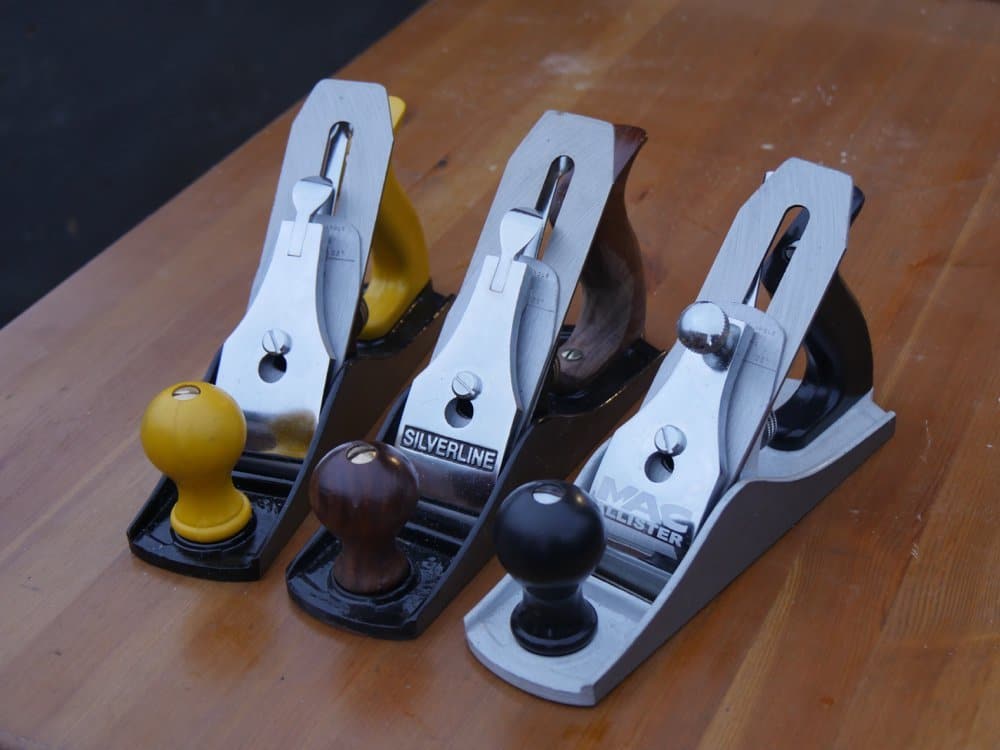
Look at the two outer planes here. These two planes are put out by B&Q. Do they look different? Yes, they do! No, they’re not. Not altogether anyway. Now the third plane, centred here in the mix, came from a very different supplier. The two companies supplying these three planes are directly in competition with one another on the high street as it were. This middle one doesn’t have plastic handles but genuine rosewood ones. Does this plane look different to the other two? Yes, it does! No, it’s not. Well not really, altogether.
I bought these first two planes from one supplier thinking I was indeed buying two very different planes made by two different makers. I wanted to run them side by side as two alternative planes for people to consider as low priced options. I think that that makes good sense on my part. Remember that one was a £10 plane and the other a £20 plane. On the one hand I was buying a B&Q plane and on the other I was buying a MACALLISTER, both sold as different planes. Indeed, looking at the packages, the planes side by side, these two planes look like Bailey-pattern #4s and indeed that’s what they are.
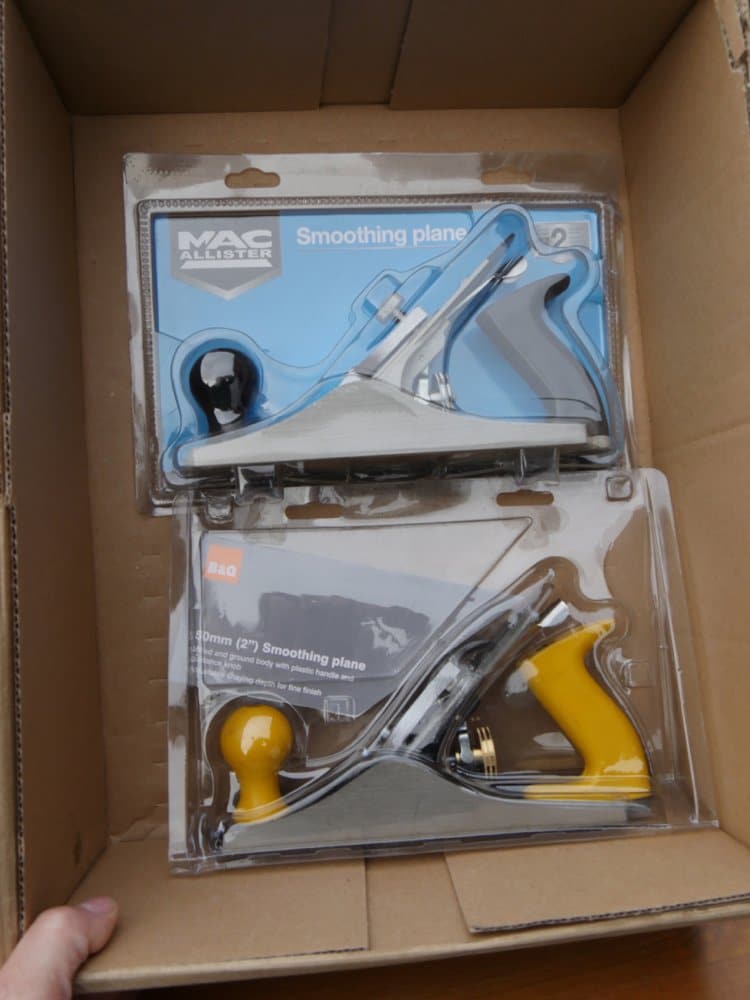
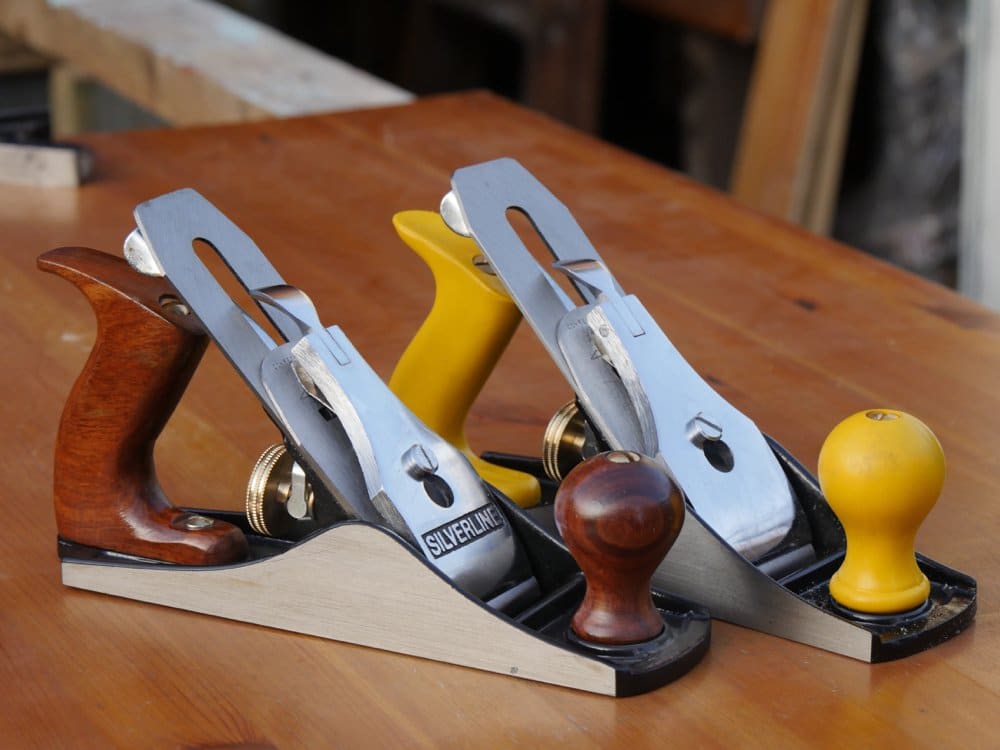
Adding the plane by Silverline, a leading UK supplier of economy rated tools, introduced yet another intriguing fact. Now I realise this may not have international significance but then again it might. Look at the three cap irons here and look closely at the stamped in words.
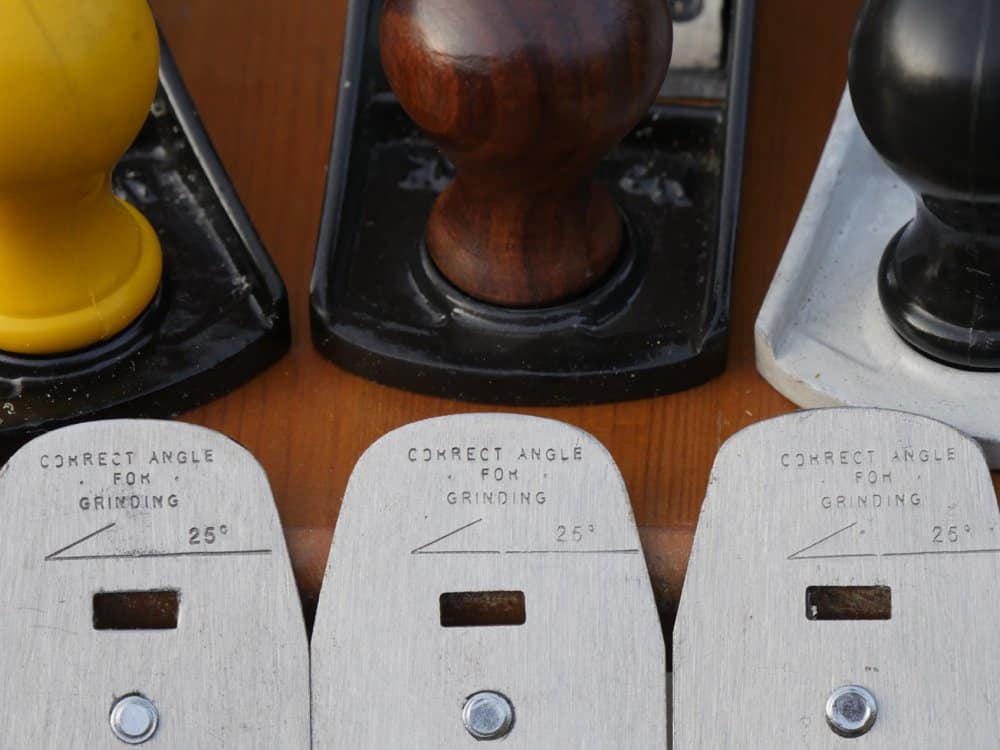
Remember that the third plane (centre) was added in from a different company altogether. You can see clearly that the cap irons are all identically made and identically marked and therefore from the same maker wherever they are in the world. Aside from the cap irons and the handle materials and colours, these planes are all identical. They are basically one and the same plane made in the same factory.
Look inside the plane frog areas here too. Different colours but that’s it. Every other feature is the same and all the parts, threads interchange except with the Silverline one which has an added screw to the handle.
So, is the MACALLISTER plane a better plane then the B&Q yellow handled one?
No, it’s not. All of the other internal components are identical. This plane produces exactly the same work. Keep £10 in your pocket and buy the £10 version of the same plane. On the other hand, if you like nice wooden handles the Silverline gives you just that.
I reshaped the tote to fit my hands but the handle was fine enough and of course wooden handles do absorb sound better than plastic. Oh, you may feel the need to avoid the lever cam after my last post stating the need for working the cam, by the way. I don’t want anyone to think working the cam was a lot of trouble as someone said. It took literally no more than 5 minutes total to fix. The other two planes did not have the issue and were already rounded on the cam just fine so perhaps i got the only one with a flawed cam.
The soles to all three planes were really rather flat and the corners to the edges as good as most I have come across.
The Silverline plane was £12.90 so I think the rosewood handles, and they were rosewood, came in at about half the price you can buy them online.
The choice is yours. if you want rosewood handles you culd go that route i suppose
Oh, yes! How did the planes perform. For brand new planes, and most planes do need a little running in, they all performed just fine. In the long term we will see how well they do. I of course have stated why I introduced these here. I think that we have seen less planes showing up on eBay of late and perhaps the slow down is due to the resurgence we have engendered through our work. The top image shows the shavings straight from the package. The below one is after sharpening. I had almost nothing I needed to do to the Silverline, even though the brand has never been known for high quality.


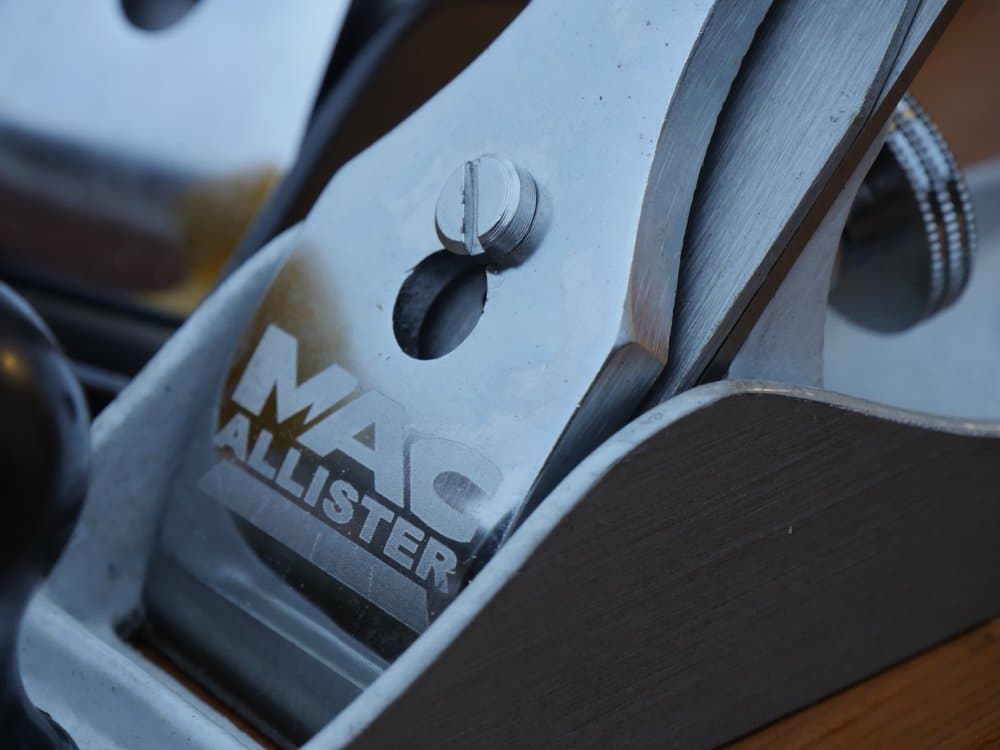

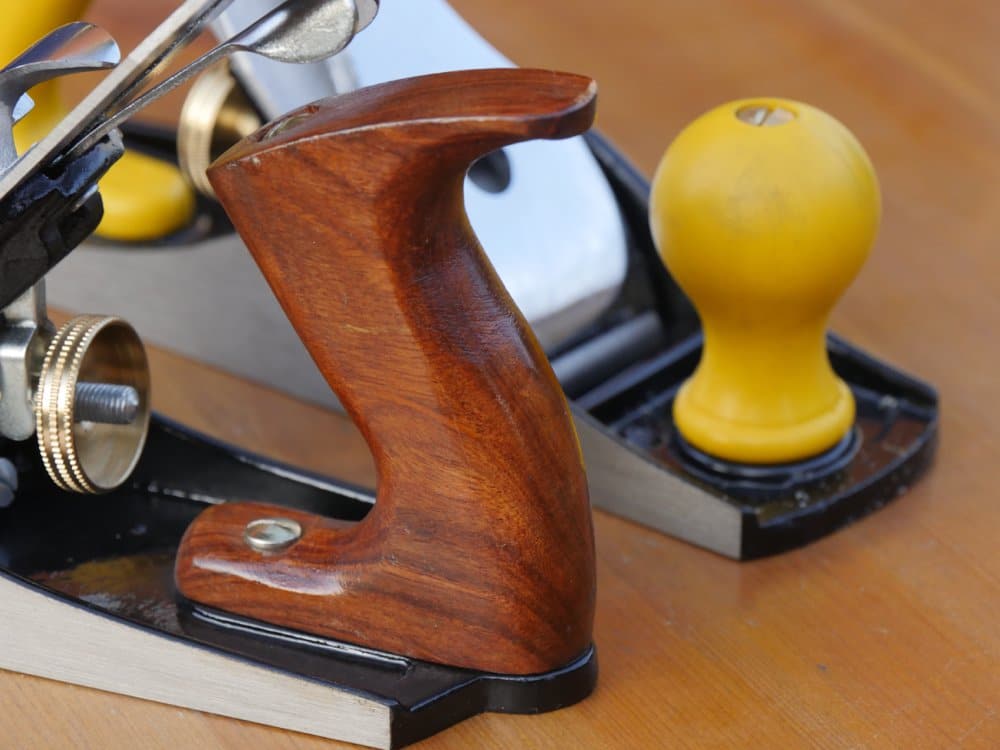
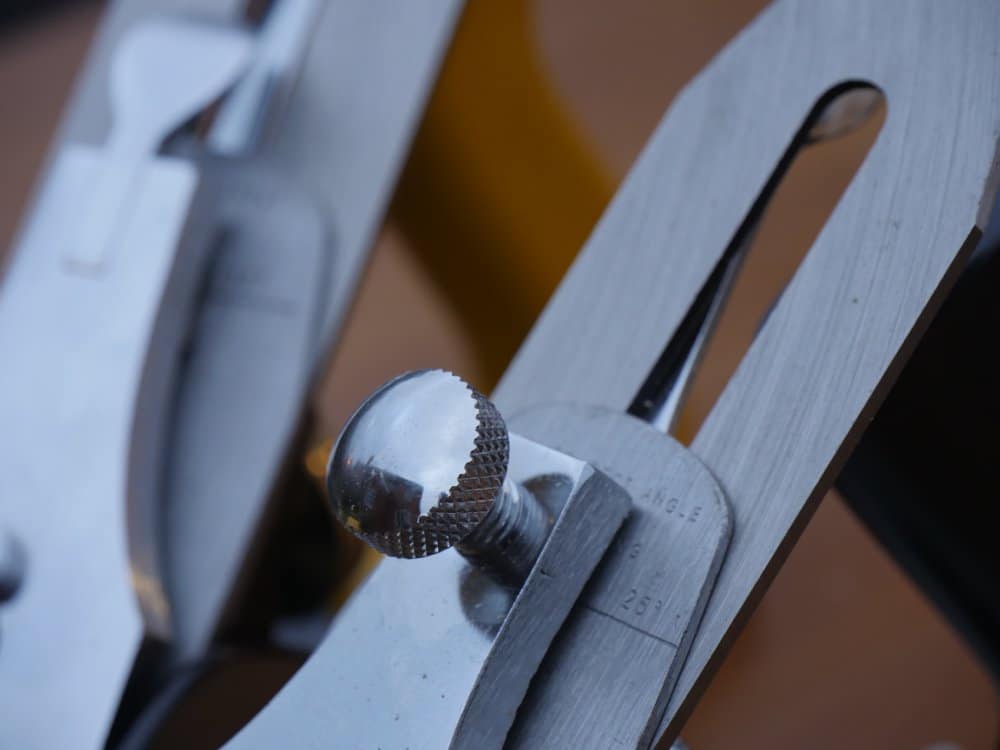
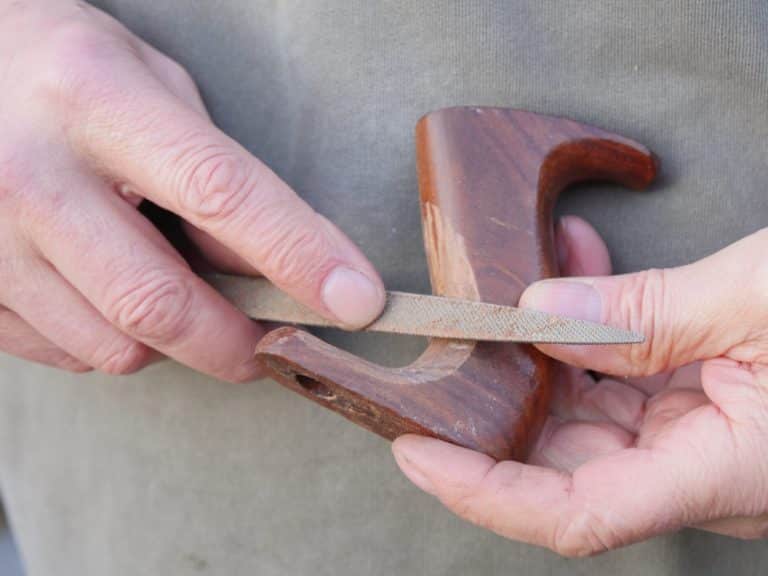
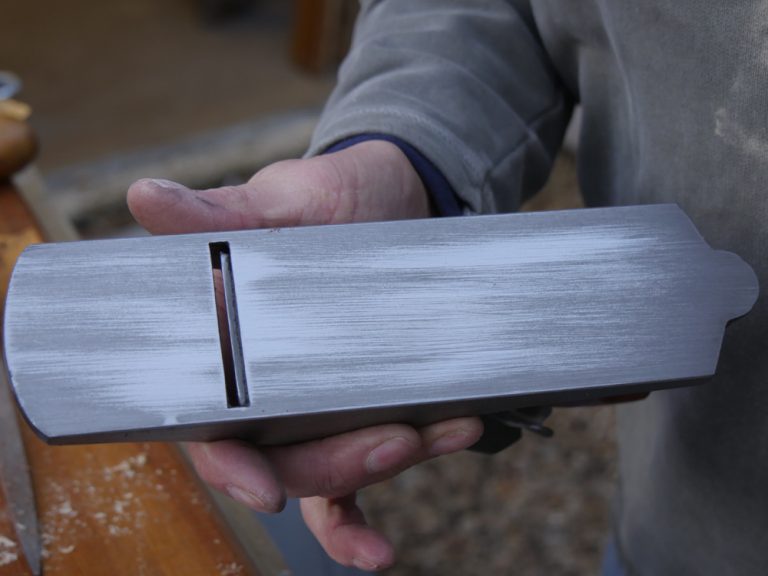
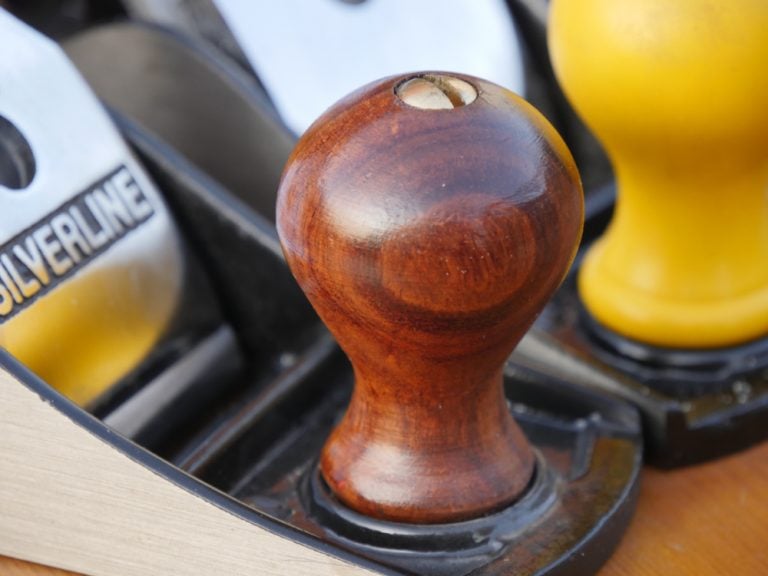
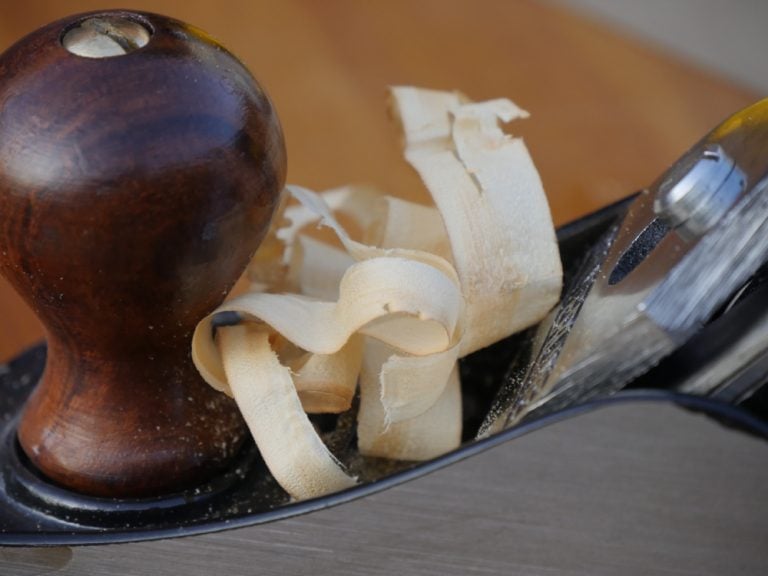
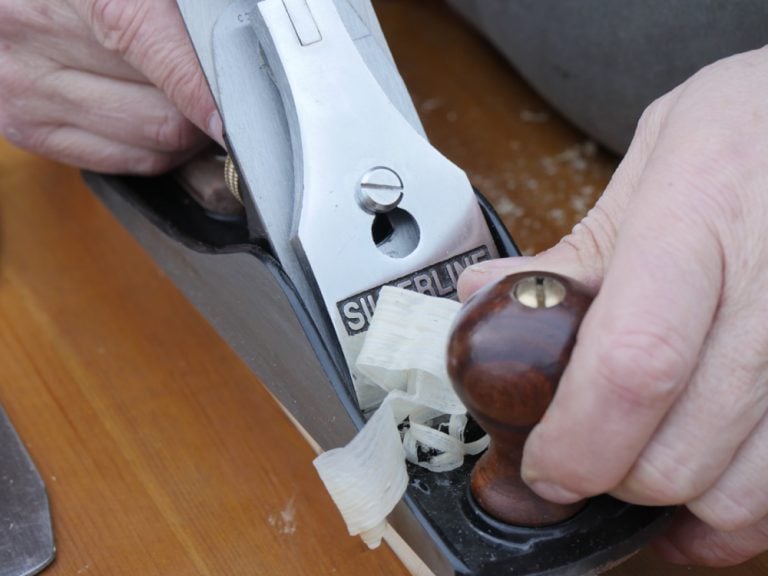
I think I have ran into the same thing with music. That is that more often then not, it seems that it is the technique and skill of the user that makes a stellar end product (be it furniture or music) rather than the quality of the tool. Granted, having quality tools is two fold: longevity and less fettling it seems, but a beginner going out and buying a complete set of planes from Veritas or Lie-Nielsen won’t mean they can make nice furniture, just like a beginner guitar player won’t be able to make beautiful music just because they own a Martin. A corollary to that would be that a beginner looking to grow his/her skillset doesn’t have to have the world’s nicest tools to have quality end results after some good lessons in technique and plenty of practice.
This is encouraging for me, mostly, because I am a budget constrained woodworker at the moment and looking to gain experience with planes such as the #4 and < $20 usd is an intriguing option to get started.
Thanks for sharing.
On the shot of the three frogs, the left hand (yellow handled) model looks to have a shallower top (far top left of the image). Or is that just lens distortion from the camera?
It wouldn’t surprise me in the slightest if they’re all being churned out of the same Chinese factory though; it’s exceptionally common with power tools.
As for the Silverline not needing any extra work, I guess that’s the lottery with cheap tools and non-existent quality control; you may get lucky, you may not. I suppose if you’re buying from a high street store it’s relatively easy to take it back and pull the gamble handle again on another sample.
I am pretty careful not to tell people these are great planes but they are definitely from the same mould or moulds and they are great to kick start in woodworking if cost really is an issue. I would that there was a good middle ground maker `i could turn to but there isn’t.
Thanks Paul. I suppose it’s likely that you could easily double the retail price of such a budget plane simply by adding a little bit of quality control at the factory. I.e. each one would be less likely to leave with a bad flaw, but overall they’d be no better than the best ones produced now (at half the price).
Whether it would be economically feasible to make something that was a significant step up for, say, £50 retail I don’t know.
I knew I should of bought that silverside #7 when I seen it in the shop, I bet it’s gone now
Hi Paul,
have you considered trying a plane made by Faithful.
A worthwhile exercise Paul. One that may open doors for many folks out there. Have you considered trying the same with the current production model of the Stanley #4? I have come close to ordering one just for curiosities sake. I just don’t have any need for an additional plane. I know that the current production model has plastice handles but the rest “looks” the same. I wonder how there current tolerances are? While there are still deals to be had on Ebay and at garage (boot) sales, the market price for older Stanley planes continues to rise. once again creating a barrier to entry for several folks.
Anyway, interesting experiment with these planes and I’m glad that you did it.
Paul have you had any experience with Groz planes?
I do, or should I say I have. The Groz planes are manufactured in India as are planes by another Indian company, Anant. These two companies came into tool making to satisfy the demand for low cost products but back in the 60s the quality was extremely bad. It would be wrong for me to even hint that that is the case today as they have held their course and remained in production through the decades. Their websites are quite impressive and so too their goals, but their initial reputation does remain with me and I am no longer sufficiently in tune with what they make today to make an evaluation. If I find their planes I wouldn’t mind trying them out again, but as I have said in the blog, at-the-bench testing is not really a one-shot deal but best done over weeks, months and years.
Paul, with the help and inspiration from your videos I rehabbed my grandfather’s Stanley no.5 about a year ago. Since then I have practiced and practiced while adding other rehabbed Stanleys to my kit. I would just like to thank you for occasionally focusing on the economically-minded woodworker in some of your videos. My Aldi chisels, Stanley/Bailey planes, and sharpened Spear & Jackson saws have brought me miles from where I started, all while teaching me a bit of skill and not hollowing my pocketbook as sometimes woodworking is perceived. I am glad to have another budget-friendly project that I can focus on while I eagerly await the release of your book. Perhaps a review of a budget-friendly mortise chisel or shoulder plane is on the horizon? The videos have affected my day immensely. Keep them coming!
Hi Paul, is that a file or rasp that you use to re-shape the tote? And what size/number is it? Thanks as ever for the instruction. I once did an evening course in woodworking at an Adult Education centre and I asked the tutor how he fettled his planes. He said that he’d never fettled his planes!
Regards
Paddy
Hi Paul, I too like rosewood handles but would not buy new ones. Rosewood is the most valuable of rainforest trees and a key trigger for its destruction. People search far and wide in virgin forest to find rosewood. The trees are enormous and heavy so once found machinery is brought in to get them out creating rough roads into previously untouched forest areas. These roads are then used to extract others trees which would not themselves be worth enough to warrant the effort of carving roads. Bush meat hunters soon follow. Without the demand for rosewood many species of tree, and many species of critter, would be much more effectively conserved. Much of this demand is from China. Some presumably from the manufacturer of the Silverline planes….
Ken – AFAIK you’re unlikely to find Brazilian rosewood (Dalbergia nigra) on much (if anything) these days – indeed I believe trade is suspended. If I recall correctly, Gibson guitars were fined a few years ago related to the use of Indian rosewood. As such I strongly doubt the Silverline planes will be using one of what would traditionally be considered a “rosewood” – even ignoring legality it’d probably be too expensive.
There are many substitutes, including Cocobolo. Personally I like Bubinga.
Hi Gordon – Interesting and good to hear folks in some places are willing to act. Its a great shame the Chinese are not willing to follow. Most rosewood whether logged legally or not ends up in China. Their new middle class apparently have a taste for imperial style furniture. Demand from woodworkers is likely trivial in comparison but through sites like Pinterest we as a group are much more influential than we might think. People covet the stuff you make (nobody covets the stuff I make). By not showcasing woods like rosewood or ebony or their lookalikes we can avoid creating destructive aspirations.
Ultimately, and though it might make Paul spit out his breakfast, perhaps what’s really needed is for the Chinese to embrace their inner Ikea. Or else more talented woodworkers than l need to show the Chinese how the imperial style can be improved by using other more sustainable timbers.
As to substitutes for plane handles I rather like the maple ones used for a time by WS Planes of Birmingham before they were bought out by Woden. Very cool especially against the dark blue paint.
I think that you are right. If someone wants to contact Silverline for verification that would be great.
The specification published on Silverlines’ UK website says the handles are rosewood. So either its real rosewood or they’re in breach of the UK trades description act. I suspect Silverline have been told rosewood by whoever manufacturers them but beyond that will have no idea.
I’m pretty certain I’ve seen reputable manufacturers use the term “rosewood” to mean other substitutes. For that matter, if I had a (questionable) source of Brazilian Rosewood (and no morals), I’m not sure I’d be practically giving it away on a plane that was retailing for £12.90; I’m sure there are other users that would pay a premium for the wood. As such, I’d be surprised if this plane was using the illegal (and valuable) stuff.
If I recall, some companies even use plantation-grown Rosewood. Not sure if that means real Rosewood or not, but it sounds nice…
There was an interesting discussion in the Woodtalk podcast from Shannon Rodgers. He’s in the lumber/timber industry and more or less said that many of the “names” of types of wood (like rosewood, mahogany, etc) have become generic marketing terms, and the only way to know what something really is is to specify the species. So I suspect in this case it’s not truly “rosewood” as we have traditionally meant the word “rosewood” to mean.
No they are not rosewood but beech but they are stained rosewood just what type of rosewood stain I’m not entirely sure but that’s why they use the word ‘rosewood’ They should say beech finished with rosewood like most honest furniture makers do. Let’s face it it’s a misleading world we live hence why it’s devoid of any blessings.
Whilst I have found this a gripping series about these planes and I continue to learn from Pauls wonderful teaching am I the only person that feels uncomfortable about paying £10 for a plane? How can it be possible to produce raw materials, manufacture components, assemble, ship and wholesale for £10. What is the least amount of human time taken to make this possible? I guess I am losing the plot when I worry stuff is just too cheap!
Good point Fraser. When we stop thinking of such things is when the plot really will be lost.
There is a great deal of concern in the whole of everything all around really. Plastic handles have their problems, carbon footprints, outsourcing our dirty laundry, cheap labour rates, quality of work and so on. These are all things that have run through my mind also. I thought of situations as with the MACALLISTER and B&Q planes. Basically one and the same. Same production costs and such. Doesn’t this mean that B&Q basically have added a £10 additional income over the other plane just for changing some colours? So now are they adding extra to benefit the producing company in, I assume, China? These are all legitimate Questions. Not sure if we can facilitate it because it is time and space consuming but then is that being irresponsible too?
This thought has lead me to wonder how much a vintage Stanley Bailey would have cost in todays terms. Based on a 1925 US catalogue, a US made #4 cost $4.40. Depending on how you work the currency conversion and rpi that works out about £40-£54 in todays money. I know there is no comparison between 1925 USA and 2016 China but thought I’d share my thoughts. About the same as a decent one on ebay today.
Yes, I am not sure of the value of comparisons with past prices. I have done this myself in defending high-end plane makers in that my first plane cost me a week’s work and thereby a weeks wage. That was around £4.50 for 48 hours. Not £4.50 an hour, but the full 5 1/2 to 6-day week. A 1st year apprentice wage was 1/7th a qualified craftsman’s wage. Most people do earn more than that now.
After looking at the planes in the post, all three are significantly better buys than the Homedepot sold Buck Brothers planes for the same price. First and foremost the Buck Brothers are lacking the the coke adjustment for the frog so you have to remove the blade to adjust frog by setting/unsetting the seat screws. Second issue I have found is the sole and top of the tote are significantly out of parallel to each other making the frog and thus the cutter canted out of square.
Does the 2 piece yoke cause concern? I have a set of Anants (3-8, plus the 4.5 and). They all needed a little work but now are in good shape. My only concern has been the 2 piece yoke. It seems flimsy compared to the on my UK made Stanley #4. I usually use that now. Am I concerned over nothing?
Also, can’t wait for the new book. I hope it is as useful as the first. My Paul Sellers bench is now the best bench ever. Well at least for me.
I don’t particularly like split yokes this way but they have been around for a while now. We are waiting on the printers now. It’s a long run but soon, very soon.
I modify split yokes by removing them then filling off the plating on the inside. Then I hold them in a small vise (aligned of course ) and sweat solder them together much as you would copper pipe. Afterward you can remove any run over with with a file. Easy to do!
The Stanley yokes are not always better. I broke one once; it had an air pocket inside the casting. The dealer gave a new frog assembly free of charge – he had seen it before. Castings can weaken and break without warning, with the pressed steel yoke you can at least see it going wrong. Not that I like them, because indeed they feel flimsy. So be careful not to overtighten the lever cap, it introduces more friction than you need.
Please excuse my ignorance (I’m new to woodworking, my interest sparked mainly through watching Pauls videos) but could someone clarify/confirm what the “Yoke” is (split or otherwise)?
May I presume it’s the bit that protrudes through the frog, cutting iron and engages with the slot in the cap iron to adjust it left and right via the lever? I just want to identify and digest the correct names of the parts of the plane.
As regards making comparisons of wages and costs from the past. My first bicycle (aged 8) cost my father a weeks wages (as he often reminded me to encourage me to look after the thing) as a train driver for BR in 1965 and the bike cost £16.
As a twelve year old doing a paper-round before school in 1969 I earned 17/6 (17 shillings and sixpence) a week.
As a sixteen year old first year craft apprentice in 1973 I was on £16 per week (40 hour week) with no overtime available to first years. Out of that I had to give my mother £8 a week for keep!
I built up my (electricians) working tool kit by mainly buying cheap second hand tools from a Saturday high street market stall (a lot of ex GPO stuff) but otherwise having to save hard and buy new from hardware shops. The most expensive item being an AVO meter Mk8 purchased through my employer from Radio Spares at a cost of £85 in my third year of apprenticeship (I was on a basic weekly wage of £28 if I remember correctly) but by then I had regular Saturday morning overtime at time and a quarter.
I still have some of the ex GPO screwdrivers (non insulated shafts!) but the AVO got sold in the late 80’s to help pay for a substitute DMM (digital multi meter), how I wish I hadn’t sold it now when I see the prices they fetch these days.
Yes, you assume rightly. The yoke pivots as a direct link from the inner area of the wheeled adjuster on the rear of the frog into the rectangular hole in the cap iron to adjust and control the depth of cut.
Thank you Sir for your usual clarity in description. I am better informed now, its just getting the names and identifying of the parts that make understanding much easier.
I hope you are settling into your new home in Abingdon. A lovely town that I have visited numerous times.
I am amazed with your findings, the fact they are all identical and even a blind man can see this and it can only be possible if made at the same factory. However this is a common practice with many companies I know this to be true of westinghouse fridges LG has always made them and LG has there own fridges, TV’s, monitors etc. My opinions of before are starting to sway is this possible that with a little bit of tune up that these cheap production planes can perform just as well as a premium plane and I am including a pre WWII planes.
Btw you pay 10-20 pounds but in this country we would pay $150 for the same plane, add another 100 and you can get a sweetheart or a woodriver. Go figure that one.
Factories are customizing products for distributors. Which select what they want from some options like handle type, quality, tolerances, what brand to print on the plane and how to package. Same for other products like sandwiches, milk, they are all produced in the same factories or group of factories. In case of this planes I think components are made in some factories, and assembled in another one, then sold under different brands. You could compare also to more expensive Stanley, you could be surprised that components are identical, maybe finish quality is better because they payed for some more expensive options.
This is why we see many brands, but product essentially is the same and there is no big competition in the area of innovation and quality. In the price area, it could be all this distributors belong to the same group. Theoretically, we should be able to order and customize our products directly from the factory like this distributors do, in practice now it is not possible if you don’t order a big number of planes.
If we don’t look at this small problems that can be fixed in an hour, do you feel the parts are good enough to work for next 100 years? You have to test them in time, but what is your feeling?
I’ve had a MACALLISTER for a while now, bought as a rough-and-ready plane for some outdoor jobs. I had expected the sole to be as up and down as a camel’s humps, but not so – it is actually within about .003in of flat and and square. I’ve seen worse on planes costing five times as much. The general build won’t win any prizes, but everything works well enough. It was hugely let down by the iron, which is among the worst pieces of steel I’ve ever encountered, the edge literally crumbling away after a few strokes. A decent replacement iron worked magic, transforming the plane into a very adequate tool that feels as if should last fairly well. Woodworking needs budget tools that encourage people to get started, and I think that blogs and videos such as Paul’s do a great service in putting the message across that with care and a bit of fettling you can own serviceable kit without spending a fortune.
I recently bought a Silverline No 4 out of curiosity. If you already have a decent Stanley or Record No 4, forego it. It’s just not up to par. You can make it work with a bit of effort, I suppose, just don’t beat the iron, as I did (also without problems with older irons) and broke it in two. The frog does not look symmetrically and I had to file away something from where the throat adjustment screw connected to the frog because it kept it from seating properly.
I do like that it has wooden handles and my guess is the wood is Dalberfia retusa / Palisander / Cocobolo. I’m quite sure it isn’t dyed beech because of the odor, oiliness and lack of characteristic appearance of beech.
I went ahead and bought three of these and found them to be working from the box apart from the need for sharpening and wiping off oil. The wood is not beech and according to Silverline is plantation grown rosewood. It works like rosewood whereas cocobolo does not work exactly like rosewood in my experience.
I also bought a silverline no. 4 recently. The quality was obviously horrible, specially with the right grinding marks, but after spending three hours working on it, it looks and registers for flatness of sole much better. After using it for a while, I realize I couldn’t get the iron to retract far enough to make thin shavings. When the depth adjustment knob was completely turned (to retract the iron) the blade was still protruding about one or two millimeters. The cap iron was set about two mm from the edge of the cutting iron. My guess is that the rectangular opening in the cap iron was wrongly punched or drilled too high, making any adjustment impossible. Would that be a manufacturing defect? Has anyone got the same problem? Should I send it back? If not I might make a scrub plane out of it, maybe backing up the cap iron would give me enough room for adjustment, although rendering it unable to act as a smoother, which was my initial hope. Any insights? Thank you!
Saïan – when you put the cap iron and blade on the frog (before fitting the lever cap) I find it’s useful to pull it back very slightly (away from the plane’s sole). Sometimes they don’t seat properly on the frog face, and a gentle pull causes them to “sit” correctly.
If that isn’t the problem – is the yoke “submarining” under the cap iron? What I mean by this is, when the depth adjustment knob is turned to fully retract the iron, has the tip of the Y shaped yoke dropped out of the hole in the cap iron? I’ve seen that once with an old (1940s) Stanley #4 – albeit when lowering rather than raising the iron. That required a replacement yoke as the original didn’t protrude enough through the frog.
Thanks for the reply! Actually the fix was simple: I took the faulty cap iron, went to my grinding wheel (old small disk, still works great) and ground off about 5mm off it, making sure that the part that contact the cutting iron stays at a correct angle to guarantee there is no gaps when they are compressed together with the screw and lever cap. It went flawlessly, and I got it square on my first attempt. I ground first 5mm, one cm away from one side, and did the same the other side. When the two where the same depth (I kept measuring it) I progressively ground the metal in between till the two sides met in a perfect straight line square to the edges (in my case the edges where parallel). I could have sent it back for free, and indeed I filed a return on eBay,and was waiting to send it off to silverline without any costs. But I though about trying his out. I cannot say how grateful I am about it. I had spent so much time flattening the sole, polishing components, squaring off the edges, filing away sharp corners and edges, modifying he level Cal’s cam like Paul showed in thia series. Would have been a shame to have to that again right? Well noe this plane is my favorite. I own about 10 wooden équivalent of a number 4 (some smallers in width, some a tad thicker) and none of them worked as well as this cheapo does. I did spend time on all of them, fiddling them to the best of my ability, making new tight wedges, flattening sanding refinishing, sharpening, polishing… name it… my girlfriend wouldn’t touch my hands anymore 😉 they do work all great, but there is something about these old steel blades..
You do have to love sharpening… but this one is now in order, I use it everyday. It’s a bit heavier than the wooden ones, but stable, and the blade does hold an edge a tad better than my kirchen 1858 smoother. Now that it’s fully working, I can say with confidence that it matches up in feel and ease of use with my #5 Dick plane (dictum Germany’s version of a wood river, quensheng, zuuma… they are all the same except handles and coating and cast finish.) I use both side by side for different tasks, and I couldn’t tell which one was the more expensive if I wasn’t the one that had to set them up. So if your up to the task, on a budget, and reluctant to the modern expensive ones, and if, like me, old Stanley’s aren’t so readily around, than feel safe buying it.
I’ve been investing some time recently on building up a decent set of planes. Following your (Paul’s) excellent videos on fettling planes, I have acquired most through eBay. They needed a lot of work including turning and carving new handles for some – woodworm had eaten one set and two others were broken. As a result i have a decent set of Stanley Bailey planes – No.s 4, 4 1/2, 5, 5 1/2. It took quite a bit of work to get them back into order but I am delighted with the results. However, finding No. 6 and No.7 planes proved more difficult. The no. 6 for example are going for £60+.
As a result I decided to chance one of the Silverline No. 6 planes. Obviously the iron needed work but that seems to be the case with every plane, even some of the expensive ones. The chip breaker needed finishing to get a good fit to the blade and that took maybe 5 minutes. For £28 including postage I have a very good plane. The sole needed a little flattening ( it took only 15 minutes with some sandpaper on my table saw) but the frog was nicely machined and set. I’ve probably overdone the setup considering what the fore plan is for but I am delighted and have bought one of their No.7 jointers. I now have a very decent set of bench planes for less than the price of one LieNielsen. I’m sure the LN are better but these old planes and the new No.6 and 7 are producing nice smooth flat wood for me. Many thanks Paul. Without your set-up videos, I think I would have felt I had to buy the expensive ones to get the results I wanted. And at those prices, I would still be planning rather than doing.
It’s a year since these articles were written and B&Q’s web-site now only features the MacAllister at £21, though the one pictured says “Forge Steel” on the lever cap — even more proof that the same things are sold under many names. I wonder if last year they were clearing-out the B&Q-branded ones, hence the very low price.
The thing that struck me was the specification saying: “Planing depth – 7mm.” A quarter-inch shaving would indeed be impressive!
Hi Paul, I have a Stanley No4 Bailey plane and the rear handle has split into two (plastic). I’d like to replace the handles with wooden ones but according to ebay prices I’d be best off buying another plane! (which would be wasteful).
Do you know if these Faithful wooden handles would fit? They are reasonably priced. https://www.uktoolcentre.co.uk/faiplane4hnd-handle-kit-for-no-4-5-6-7-no-10-planes.html?gclid=EAIaIQobChMIqfKx39nl4QIVbrHtCh00AAv8EAQYASABEgLYf_D_BwE